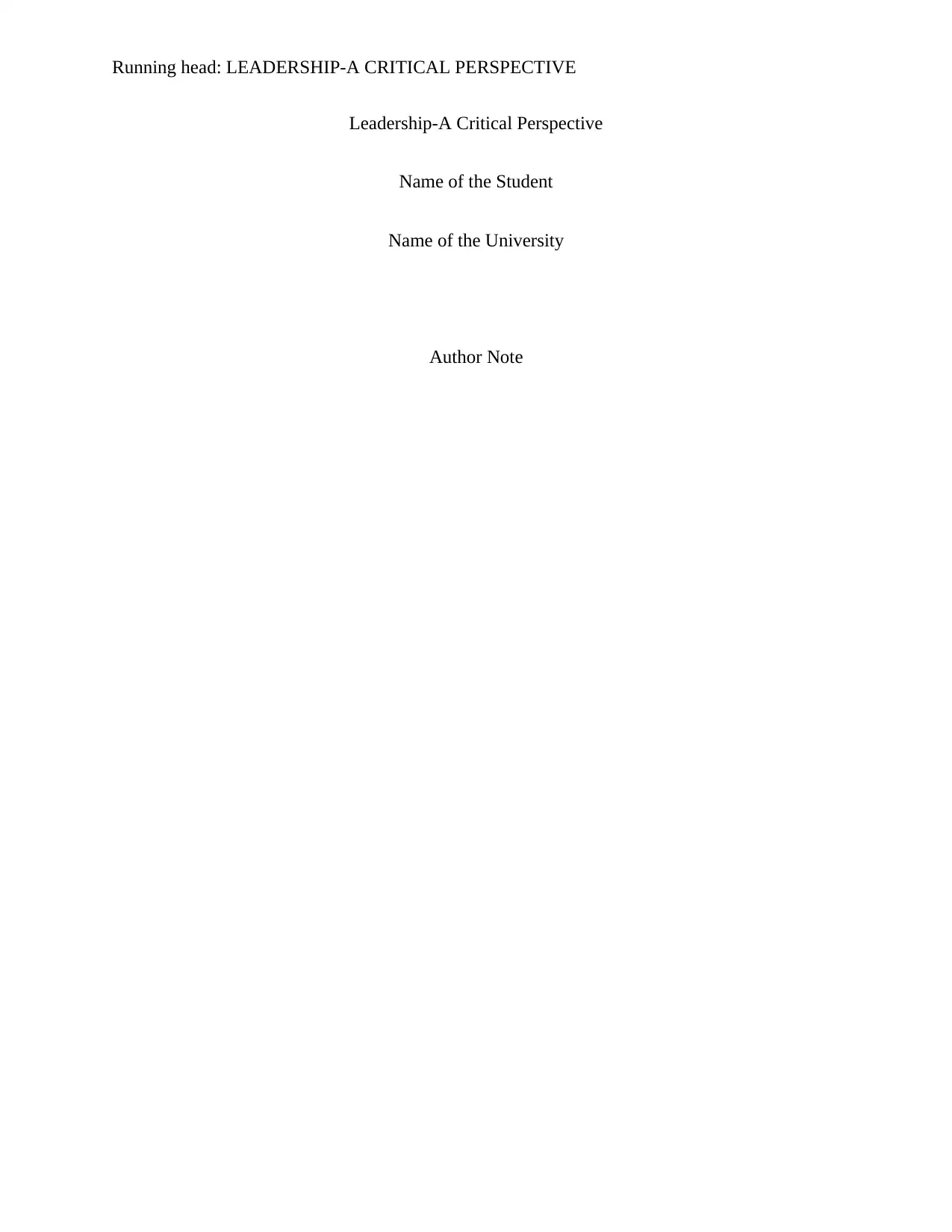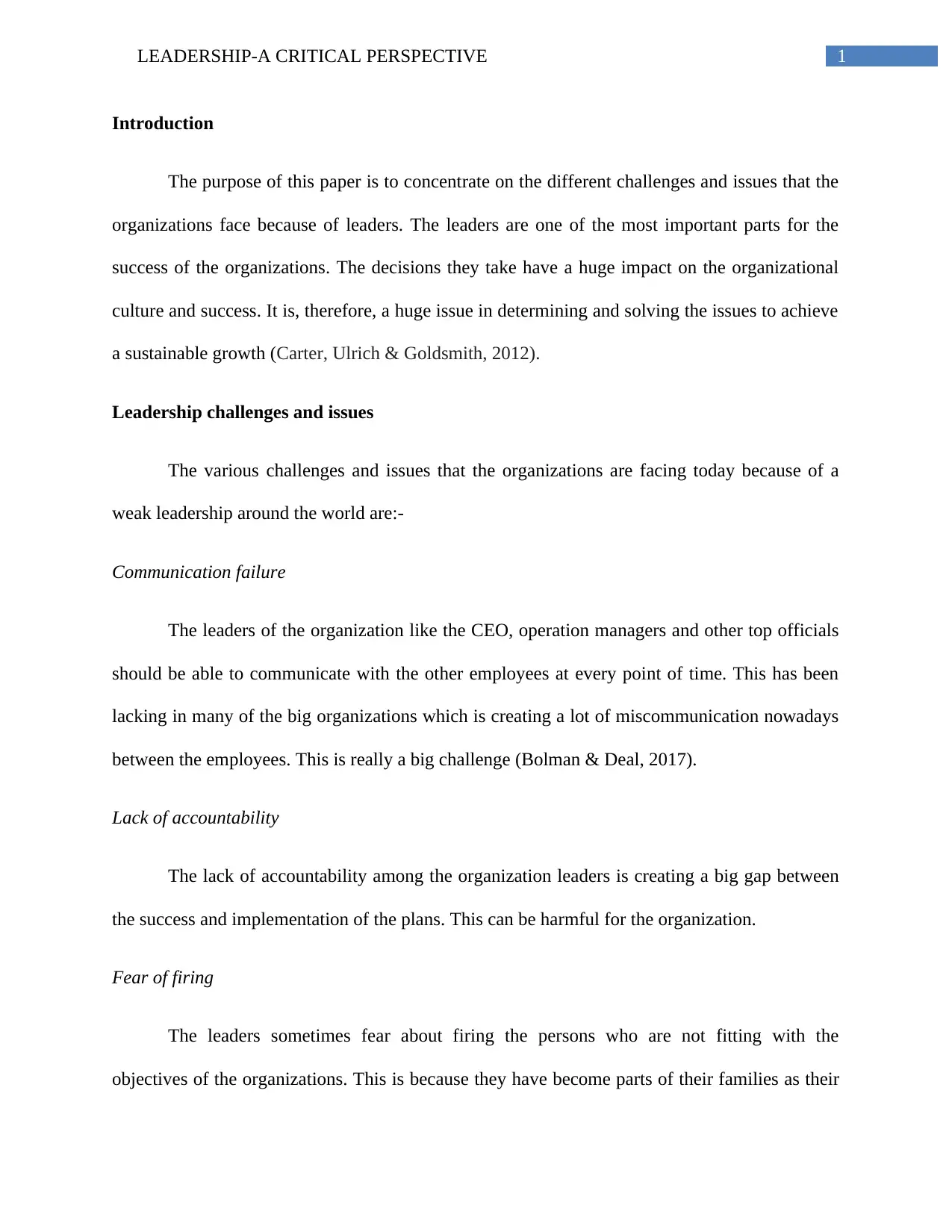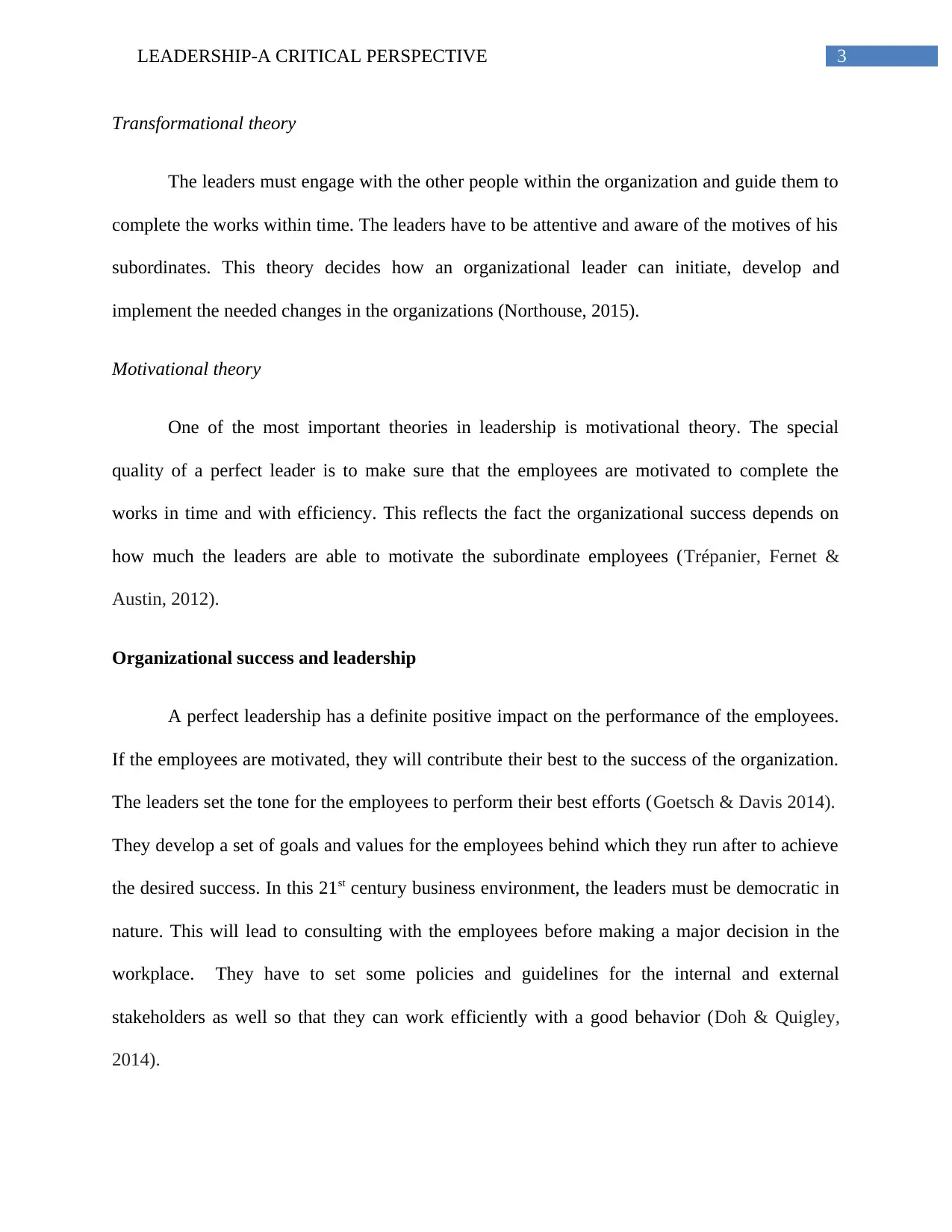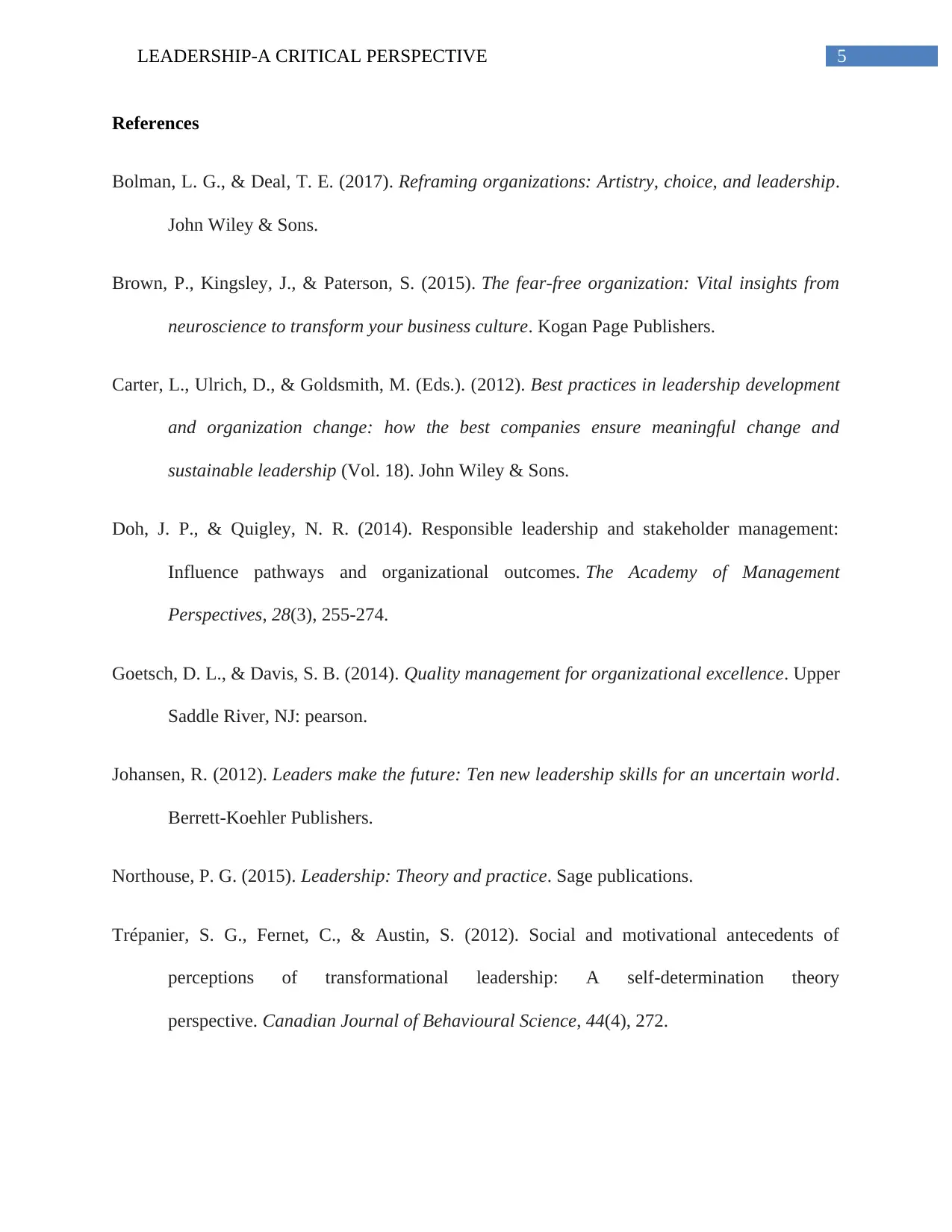Leadership in Organizations: Challenges, Theories, and Success Factors
VerifiedAdded on 2020/02/24
|6
|1118
|133
Essay
AI Summary
This essay critically examines the multifaceted challenges faced by organizations due to leadership, emphasizing the crucial role leaders play in organizational success and culture. It identifies key leadership issues such as communication failures, lack of accountability, fear of firing, lack of clear vision, and poor execution. The essay then explores several prominent leadership theories, including situational, transformational, and motivational theories, highlighting their application in the modern business environment. Furthermore, it analyzes the direct impact of effective leadership on employee performance and organizational success, underscoring the importance of democratic leadership and the establishment of clear policies. The conclusion reinforces the significance of leaders as primary decision-makers and drivers of organizational growth.

Running head: LEADERSHIP-A CRITICAL PERSPECTIVE
Leadership-A Critical Perspective
Name of the Student
Name of the University
Author Note
Leadership-A Critical Perspective
Name of the Student
Name of the University
Author Note
Paraphrase This Document
Need a fresh take? Get an instant paraphrase of this document with our AI Paraphraser

1LEADERSHIP-A CRITICAL PERSPECTIVE
Introduction
The purpose of this paper is to concentrate on the different challenges and issues that the
organizations face because of leaders. The leaders are one of the most important parts for the
success of the organizations. The decisions they take have a huge impact on the organizational
culture and success. It is, therefore, a huge issue in determining and solving the issues to achieve
a sustainable growth (Carter, Ulrich & Goldsmith, 2012).
Leadership challenges and issues
The various challenges and issues that the organizations are facing today because of a
weak leadership around the world are:-
Communication failure
The leaders of the organization like the CEO, operation managers and other top officials
should be able to communicate with the other employees at every point of time. This has been
lacking in many of the big organizations which is creating a lot of miscommunication nowadays
between the employees. This is really a big challenge (Bolman & Deal, 2017).
Lack of accountability
The lack of accountability among the organization leaders is creating a big gap between
the success and implementation of the plans. This can be harmful for the organization.
Fear of firing
The leaders sometimes fear about firing the persons who are not fitting with the
objectives of the organizations. This is because they have become parts of their families as their
Introduction
The purpose of this paper is to concentrate on the different challenges and issues that the
organizations face because of leaders. The leaders are one of the most important parts for the
success of the organizations. The decisions they take have a huge impact on the organizational
culture and success. It is, therefore, a huge issue in determining and solving the issues to achieve
a sustainable growth (Carter, Ulrich & Goldsmith, 2012).
Leadership challenges and issues
The various challenges and issues that the organizations are facing today because of a
weak leadership around the world are:-
Communication failure
The leaders of the organization like the CEO, operation managers and other top officials
should be able to communicate with the other employees at every point of time. This has been
lacking in many of the big organizations which is creating a lot of miscommunication nowadays
between the employees. This is really a big challenge (Bolman & Deal, 2017).
Lack of accountability
The lack of accountability among the organization leaders is creating a big gap between
the success and implementation of the plans. This can be harmful for the organization.
Fear of firing
The leaders sometimes fear about firing the persons who are not fitting with the
objectives of the organizations. This is because they have become parts of their families as their

2LEADERSHIP-A CRITICAL PERSPECTIVE
team members. This shows the moral weakness of the leaders that is a negative point ( Brown,
Kingsley & Paterson, 2015).
Lack of clear vision
It is an obvious fact that the leaders of an organization must have a clear vision about
their organizational objectives. So, the leaders must be clear to themselves about what they want
from their employees. If this feature lacks, the companies are going to suffer a lot.
Poor execution
The leaders have to be experts in the implementation of the organizational plans. These
plans must be executed by the managers and leaders properly by allocating the works to the
suitable employees (Johansen, 2012). It has happened often times, they have not been able to
understand the worth of their employees and the organizational growth has suffered because of
the poor execution of the plans by the leaders.
Leadership theories
Some of the important leadership theories in the modern day business environment are:-
Situational theory
According to this theory, the leaders must be able to adjust themselves to different
situations. Different challenging situations may arise in the workplace because of different
reasons (Northouse, 2015). These challenges have to be managed and the positive things have to
be extracted by the leaders because of this. These situational adjustments signify the positive
qualities of the leaders.
team members. This shows the moral weakness of the leaders that is a negative point ( Brown,
Kingsley & Paterson, 2015).
Lack of clear vision
It is an obvious fact that the leaders of an organization must have a clear vision about
their organizational objectives. So, the leaders must be clear to themselves about what they want
from their employees. If this feature lacks, the companies are going to suffer a lot.
Poor execution
The leaders have to be experts in the implementation of the organizational plans. These
plans must be executed by the managers and leaders properly by allocating the works to the
suitable employees (Johansen, 2012). It has happened often times, they have not been able to
understand the worth of their employees and the organizational growth has suffered because of
the poor execution of the plans by the leaders.
Leadership theories
Some of the important leadership theories in the modern day business environment are:-
Situational theory
According to this theory, the leaders must be able to adjust themselves to different
situations. Different challenging situations may arise in the workplace because of different
reasons (Northouse, 2015). These challenges have to be managed and the positive things have to
be extracted by the leaders because of this. These situational adjustments signify the positive
qualities of the leaders.
⊘ This is a preview!⊘
Do you want full access?
Subscribe today to unlock all pages.

Trusted by 1+ million students worldwide

3LEADERSHIP-A CRITICAL PERSPECTIVE
Transformational theory
The leaders must engage with the other people within the organization and guide them to
complete the works within time. The leaders have to be attentive and aware of the motives of his
subordinates. This theory decides how an organizational leader can initiate, develop and
implement the needed changes in the organizations (Northouse, 2015).
Motivational theory
One of the most important theories in leadership is motivational theory. The special
quality of a perfect leader is to make sure that the employees are motivated to complete the
works in time and with efficiency. This reflects the fact the organizational success depends on
how much the leaders are able to motivate the subordinate employees (Trépanier, Fernet &
Austin, 2012).
Organizational success and leadership
A perfect leadership has a definite positive impact on the performance of the employees.
If the employees are motivated, they will contribute their best to the success of the organization.
The leaders set the tone for the employees to perform their best efforts (Goetsch & Davis 2014).
They develop a set of goals and values for the employees behind which they run after to achieve
the desired success. In this 21st century business environment, the leaders must be democratic in
nature. This will lead to consulting with the employees before making a major decision in the
workplace. They have to set some policies and guidelines for the internal and external
stakeholders as well so that they can work efficiently with a good behavior (Doh & Quigley,
2014).
Transformational theory
The leaders must engage with the other people within the organization and guide them to
complete the works within time. The leaders have to be attentive and aware of the motives of his
subordinates. This theory decides how an organizational leader can initiate, develop and
implement the needed changes in the organizations (Northouse, 2015).
Motivational theory
One of the most important theories in leadership is motivational theory. The special
quality of a perfect leader is to make sure that the employees are motivated to complete the
works in time and with efficiency. This reflects the fact the organizational success depends on
how much the leaders are able to motivate the subordinate employees (Trépanier, Fernet &
Austin, 2012).
Organizational success and leadership
A perfect leadership has a definite positive impact on the performance of the employees.
If the employees are motivated, they will contribute their best to the success of the organization.
The leaders set the tone for the employees to perform their best efforts (Goetsch & Davis 2014).
They develop a set of goals and values for the employees behind which they run after to achieve
the desired success. In this 21st century business environment, the leaders must be democratic in
nature. This will lead to consulting with the employees before making a major decision in the
workplace. They have to set some policies and guidelines for the internal and external
stakeholders as well so that they can work efficiently with a good behavior (Doh & Quigley,
2014).
Paraphrase This Document
Need a fresh take? Get an instant paraphrase of this document with our AI Paraphraser

4LEADERSHIP-A CRITICAL PERSPECTIVE
Conclusion
This conclusion to this paper can be drawn in a manner that the organizational leaders are
the heart of the organization who are the major decision makers and the ones on whom the
success of the organization lies. They have to play a major positive role in determining the
organization’s growth and leadership success.
Conclusion
This conclusion to this paper can be drawn in a manner that the organizational leaders are
the heart of the organization who are the major decision makers and the ones on whom the
success of the organization lies. They have to play a major positive role in determining the
organization’s growth and leadership success.

5LEADERSHIP-A CRITICAL PERSPECTIVE
References
Bolman, L. G., & Deal, T. E. (2017). Reframing organizations: Artistry, choice, and leadership.
John Wiley & Sons.
Brown, P., Kingsley, J., & Paterson, S. (2015). The fear-free organization: Vital insights from
neuroscience to transform your business culture. Kogan Page Publishers.
Carter, L., Ulrich, D., & Goldsmith, M. (Eds.). (2012). Best practices in leadership development
and organization change: how the best companies ensure meaningful change and
sustainable leadership (Vol. 18). John Wiley & Sons.
Doh, J. P., & Quigley, N. R. (2014). Responsible leadership and stakeholder management:
Influence pathways and organizational outcomes. The Academy of Management
Perspectives, 28(3), 255-274.
Goetsch, D. L., & Davis, S. B. (2014). Quality management for organizational excellence. Upper
Saddle River, NJ: pearson.
Johansen, R. (2012). Leaders make the future: Ten new leadership skills for an uncertain world.
Berrett-Koehler Publishers.
Northouse, P. G. (2015). Leadership: Theory and practice. Sage publications.
Trépanier, S. G., Fernet, C., & Austin, S. (2012). Social and motivational antecedents of
perceptions of transformational leadership: A self-determination theory
perspective. Canadian Journal of Behavioural Science, 44(4), 272.
References
Bolman, L. G., & Deal, T. E. (2017). Reframing organizations: Artistry, choice, and leadership.
John Wiley & Sons.
Brown, P., Kingsley, J., & Paterson, S. (2015). The fear-free organization: Vital insights from
neuroscience to transform your business culture. Kogan Page Publishers.
Carter, L., Ulrich, D., & Goldsmith, M. (Eds.). (2012). Best practices in leadership development
and organization change: how the best companies ensure meaningful change and
sustainable leadership (Vol. 18). John Wiley & Sons.
Doh, J. P., & Quigley, N. R. (2014). Responsible leadership and stakeholder management:
Influence pathways and organizational outcomes. The Academy of Management
Perspectives, 28(3), 255-274.
Goetsch, D. L., & Davis, S. B. (2014). Quality management for organizational excellence. Upper
Saddle River, NJ: pearson.
Johansen, R. (2012). Leaders make the future: Ten new leadership skills for an uncertain world.
Berrett-Koehler Publishers.
Northouse, P. G. (2015). Leadership: Theory and practice. Sage publications.
Trépanier, S. G., Fernet, C., & Austin, S. (2012). Social and motivational antecedents of
perceptions of transformational leadership: A self-determination theory
perspective. Canadian Journal of Behavioural Science, 44(4), 272.
⊘ This is a preview!⊘
Do you want full access?
Subscribe today to unlock all pages.

Trusted by 1+ million students worldwide
1 out of 6
Related Documents
Your All-in-One AI-Powered Toolkit for Academic Success.
+13062052269
info@desklib.com
Available 24*7 on WhatsApp / Email
![[object Object]](/_next/static/media/star-bottom.7253800d.svg)
Unlock your academic potential
Copyright © 2020–2025 A2Z Services. All Rights Reserved. Developed and managed by ZUCOL.




